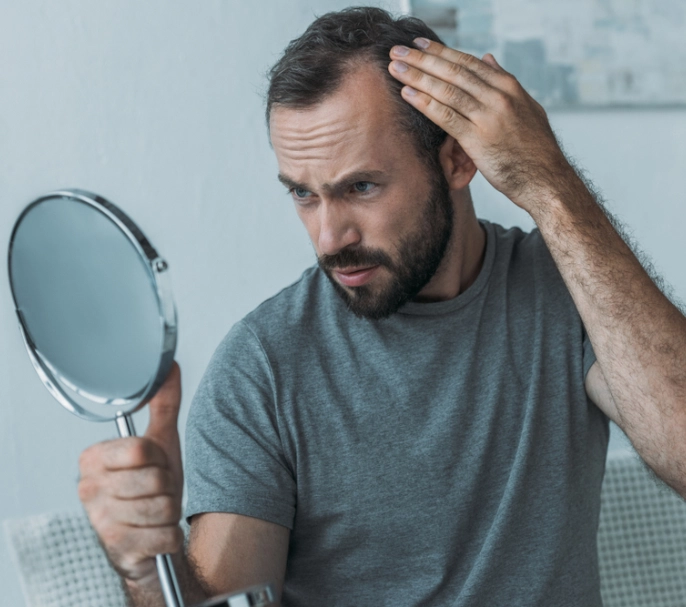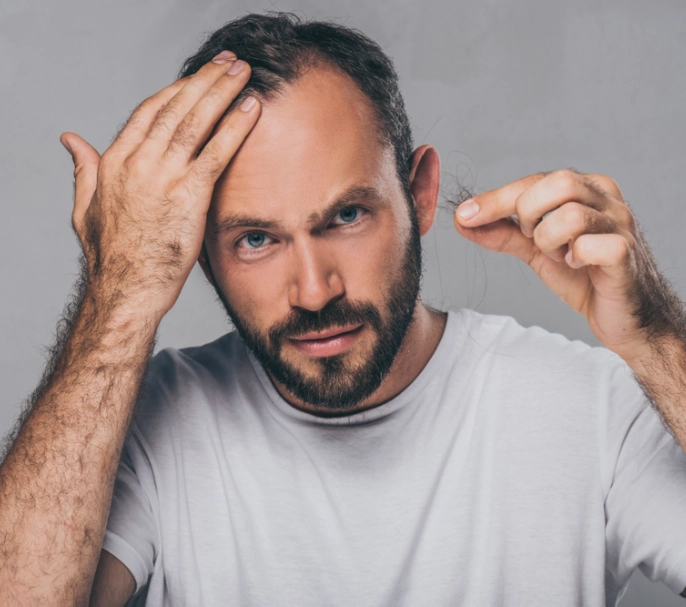
Male Hair Loss
On these pages we would like to inform you about the best known and most common forms of hair loss in men.
Get In Touch
Hereditary Hair Loss
Hereditary hair loss is the most common form of hair loss in men, accounting for 95 percent of cases. Around 60% of men are familiar with the problem of hair loss from their own experience. Hereditary or androgenetic hair loss in men means that the development of hair loss is preprogrammed in the genes.
The loss of hair becomes evident through a receding hairline and at the back of the head.
The Cause
The cause of hereditary hair loss is a hypersensitivity of the hair root to the body’s own hormone dihydrotestosterone (DHT), which is formed in the hair root from testosterone.
The hair loss process
1 – In the hair root, DHT is formed from testosterone with the help of the enzyme 5-alpha-reductase.
2 – If predisposed to do so, the hair root reacts sensitively to DHT and gradually dies.
3 – The hair falls out.
Get In Touch

Diffuse Hair Loss
If the entire head is affected by hair loss and the number of hairs lost exceeds the normal amount of 100 hairs per day, this is diffuse hair loss. Although the hair bulb is intact, it is not sufficiently supplied with nutrients like amino acids (e.g. cystine) and B-group vitamins through the bloodstream.
This has consequences:
– The hair bulb ceases its activity at some point.
– The life of the hair is shortened.
– It falls out prematurely.
– Increased hair loss is the result.
The reasons for diffuse hair loss in men are many and varied and can be related to certain life circumstances:
– Stress
– Nutritional deficits/diet
– Severe infections, e.g. flu
– Certain metabolic disorders
– Special form of seasonal hair loss (hair loss in spring or autumn)
Get In Touch


Treatment
The cause of diffuse hair loss should be identified and, if possible, eliminated during a visit to the doctor.
Hair loss can also be successfully treated by supplying suitable nutrients, e.g. Pantogar®.
Because of the hair’s life cycle, the treatment should be carried out for at least 3 to 6 months.
3
Times a day
3 - 6
Months
Alopecia Areata
This form of hair loss is also called circular hair loss, or spot baldness. It is characterised by distinct, sharply defined bald patches of different sizes.
Alopecia areata is an inflammatory, usually reversible form of hair loss. The cause is unknown. Most likely, immunological (concerning the body’s defence mechanism) processes play a role in the development of the disease. Hereditary factors also seem to be of relevance, as in about 25% of cases the disease occurs in families.
Alopecia areata should be treated by a doctor.
Get In Touch

Causes Of Male Hair Loss
Hair Loss Due To Hair Structure Damage
Repeated damage to the hair – for instance through excessive handling during styling and haircare – causes the hair shaft to split and break off. Severe hair breakage leads to thin, sparse hair and finally to thinning hair, which is often confused with pathological hair loss. When hair structure damage occurs, the hair breaks off over the scalp and the hair roots remain active.
Causes
The causes of such hair structure damage are many and varied. Usually these are external damaging influences, such as:
1 – Mechanical influences (intensive combing, brushing, backcombing, pulling through elastic bands, tight plaits)
2 – Chemical damage (tinting, colouring, bleaching, perming, frequent washing with alkaline shampoos)
3 – Physical influences (excessive heat from blow-drying, intensive sun or solarium exposure, UV radiation)
Hair loss due to hair structure damage can be treated, for example, with Pantogar® capsules.
Get In Touch

Hair Loss Due To Stress
Hair Loss Due To Hair Structure Damage
If stress persists over a long period of time or if there is a particularly large number of burdens to overcome, this can lead to hair loss.
This phenomenon is caused by various neurotransmitters (messengers) that negatively affect the hair follicles. Each hair follicle is surrounded by a dense network of nerve fibres containing various neuronal messengers.
Stress increases the concentration of the key messengers and thus the number of nerve fibres in the hair follicles. If this happens during the transition of the hair from the growth phase to the resting phase, the hair follicle becomes inflamed and hair growth stops prematurely. The result is diffuse hair loss.
Get In Touch
Stress avoidance
The easiest and most effective way to prevent stress-related hair loss is to not give stress a chance in the first place. Besides good time management, getting enough sleep also helps, so that the body can recover.
Yoga and autogenic training
The best-known method of relaxation and stress-relief is yoga, a technique that originated in India involving set poses and breathing exercises. Autogenic training, a kind of self-hypnosis, can also restore a balance between states of tension and relaxation. Both yoga and autogenic training can be done at home, after a short familiarization period.
Supplying nutrients
If your hair loss does not subside, it is advisable to tackle the problem at its root – literally – with a product that, with a balanced combination of amino acids containing Sulphur and B-group vitamins, helps to supply the hair with exactly the nutrients it needs to grow healthily. One recommendation is, for example, Pantogar®.
Professional Advise
The right advice is the basis for successful treatment
We all know them, have been advised to try them or have actually tried them: tips, tricks and household remedies to help with hair loss. Sometimes it even works – they say faith moves mountains – but sometimes it doesn’t. So spare yourself the detours and get professional help right from the start. Consult your physician to help you determine the cause of your hair loss and treat it directly. One effective treatment option are Pantogar® capsules.
Pantogar® capsules are a medication available over the counter in your pharmacy, and unlike many other products theirefficacy has been proven in numerous studies. Pantogar® anti-hair loss formula contains an specifically formulated active substance complex which stops hair loss and stimulates the growth of new hair.
To prepare optimally for a doctor’s visit, use the questionnaire here which you can complete in advance. For a list of places where you can find Pantogar®
Get In Touch

Hair Loss And The Thyroid
Thyroid disorders can trigger hair loss. A thyroid disorder can be diagnosed by a blood test. The thyroid hormones T3 (triiodothyronine) and T4 (thyroxine), which influence the body’s metabolism and have a direct influence on hair-forming cells in the human organism, are responsible for hair loss.
An overactive thyroid (hyperthyroidism) manifests itself in thinner, finer and more brittle hair. Since the hair switches to the resting phase earlier, it only reaches a short length.
In the case of an underactive thyroid (hypothyroidism), the hair appears dull, lifeless, dry and brittle. Hair density and hair diameter may be reduced.
If the thyroid disorder is eliminated, hair loss can improve.
There is no correlation between the severity of hair loss and the intensity of the thyroid disorder. A severe hormone deficiency does not automatically lead to severe hair loss. And in reverse, severe hair loss can even occur if the thyroid is only slightly overactive or underactive. There are experts who consider the correlation between thyroid disorders and hair loss to be unproven and even unlikely.
Hair loss due to medication for thyroid disorders
Hair loss can also be caused by medication taken for an overactive thyroid. Examples include thyrostatics, carbimazole, thiamazole, methylthiouracil and propylthiouracil.
Hair loss can also be caused by medications that interfere with the thyroid metabolism: iodides, levothyroxine, amiodarone and lithium.
Get In Touch
How Your Doctor Diagnoses Hair Loss
You have prepared well for your appointment with a medical specialist and are wondering how the doctor will proceed during your consultation? You would like to know what procedures they might use to find out the cause of your hair loss?
Depending on the degree of hair loss, your doctor may diagnose you using different procedures:
Scalp Inspection / Hair Parting
he doctor will usually examine your hair under a bright lamp. They check the hair structure, scalp and hair density thoroughly.
Depending on the type of hair loss or scalp disorder, the skin of the entire body is checked and conspicuous areas are examined using an incident light microscope. Examination of body hair can also be necessary for many types of hair loss.
Image source: Textbook source: Textbook “Hair – Practice of Trichology” by Prof. Ralph M. Trüeb, Steinkopff Verlag, Darmstadt.


Need Help?
Send your inquiry and let’s get in touch with oursupport team
Contact Us
